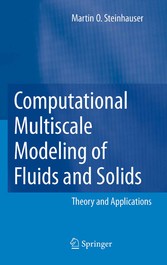Suchen und Finden
Service
Computational Multiscale Modeling of Fluids and Solids - Theory and Applications
Martin Oliver Steinhauser
Verlag Springer-Verlag, 2007
ISBN 9783540751175 , 428 Seiten
Format PDF
Kopierschutz Wasserzeichen
Geräte
Preface
6
Contents
12
Part I Fundamentals
17
1 Introduction
18
1.1 Physics on Different Length- and Timescales
19
1.2 What are Fluids and Solids?
24
1.3 The Objective of Experimental and Theoretical Physics
27
1.4 Computer Simulations – A Review
28
1.5 Suggested Reading
40
2 Multiscale Computational Materials Science
42
2.1 Some Terminology
45
2.2 What is Computational Material Science on Multiscales?
46
2.3 What is a Model?
50
2.4 Hierarchical Modeling Concepts above the Atomic Scale
59
2.5 Unification and Reductionism in Physical Theories
70
2.6 Computer Science, Algorithms, Computability and Turing Machines
92
Problems
121
3 Mathematical and Physical Prerequisites
123
3.1 Introduction
123
3.2 Sets and Set Operations
127
3.3 Topological Spaces
141
3.4 Metric Spaces and Metric Connection
173
3.5 Riemannian Manifolds
176
3.6 The Problem of Inertia and Motion: Coordinate Systems in Physics
179
3.7 Relativistic Field Equations
185
3.8 Suggested Reading
189
Problems
189
4 Fundamentals of Numerical Simulation
192
4.1 Basics of Ordinary and Partial Differential Equations in Physics
192
4.2 Numerical Solution of Differential Equations
202
4.3 Elements of Software Design
218
Problems
230
Part II Computational Methods on Multiscales
231
Summary of Part I
232
5 Computational Methods on Electronic/ Atomistic Scale
235
5.1 Introduction
235
5.2 Ab-initio Methods
236
5.3 Physical Foundations of Quantum Theory
240
5.4 Density Functional Theory
247
5.5 Car-Parinello Molecular Dynamics
249
5.6 Solving Schr¨ odinger’s Equation for Many-Particle Systems: Quantum Mechanics of Identical Particles
253
5.7 What Holds a Solid Together?
266
5.8 Semi-empirical Methods
269
5.9 Bridging Scales: Quantum Mechanics (QM) – Molecular Mechanics ( MM)
275
5.10 Concluding Remarks
276
6 Computational Methods on Atomistic/ Microscopic Scale
278
6.1 Introduction
278
6.2 Fundamentals of Statistical Physics and Thermodynamics
284
6.3 Classical Interatomic and Intermolecular Potentials
293
6.4 Classical Molecular Dynamics Simulations
303
6.5 Liquids, Soft Matter and Polymers
322
6.6 Monte Carlo Method
332
Problems
336
7 Computational Methods on Mesoscopic/ Macroscopic Scale
337
7.1 Example: Meso- and Macroscale Shock-Wave Experiments with Ceramics
340
7.2 Statistical Methods: Voronoi Tesselations and Power Diagrams for Modeling Microstructures of Ceramics
342
7.3 Dissipative Particle Dynamics
348
7.4 Ginzburg-Landau/Cahn-Hiliard Field Theoretic Mesoscale Simulation Method
350
7.5 Bridging Scales: Soft Particle Discrete Elements for Shock Wave Applications
352
7.6 Bridging Scales: Energetic Links between MD and FEM
362
7.7 Physical Theories for Macroscopic Phenomena: The Continuum Approach
365
7.8 Continuum Theory
368
7.9 Theory of Elasticity
371
7.10 Bridging Scale Application: Crack Propagation in a Brittle Specimen
383
8 Perspectives in Multiscale Materials Modeling
385
A Further Reading
388
General Physics
388
Programming Techniques
388
Journals and Conferences on Multiscale Materials Modeling and Simulation
389
B Mathematical Definitions
390
C Sample Code for the Main Routine of a MD Simulation
392
D A Sample Makefile
394
E Tables of Physical Constants
396
E.1 International System of Units (SI or mksA System)
396
E.2 Conversion Factors of Energy
397
List of Algorithms
398
List of Boxes
399
Solutions
400
Problems of Chapter 2
400
Problems of Chapter 3
403
Problems of Chapter 4
404
References
406
Index
428
Service
Shop



















